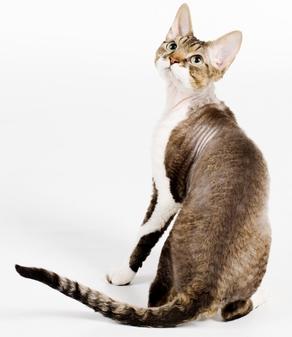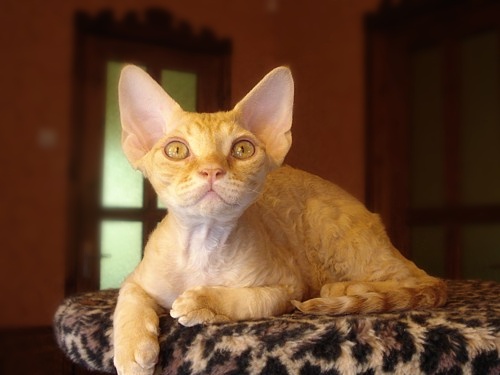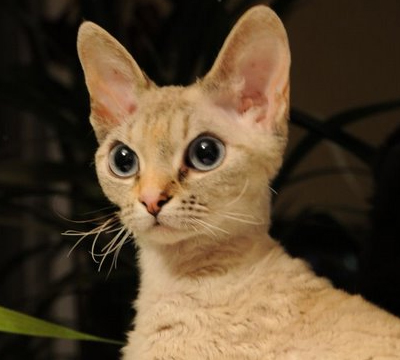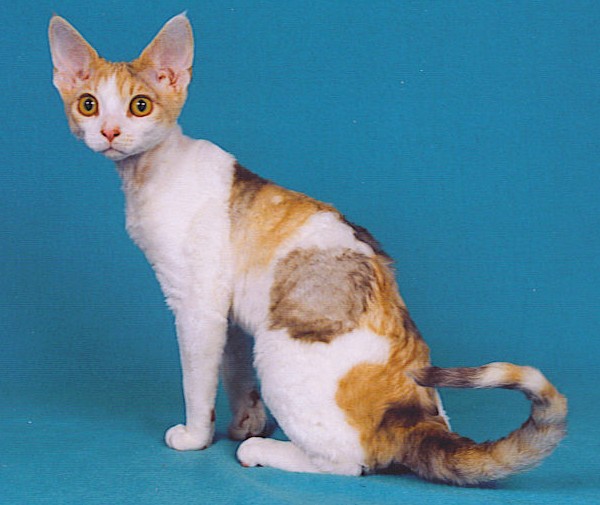The Devon Rex Cat Breed
History
The history of the Devon Rex cat breed started in a small town in England. A feral tom cat with a curly coat lived in an abandoned mine in Buckfastleigh, Devon. In 1960, Miss Beryl Cox adopted a tortie and white stray cat. This tom cat and Miss Cox’s cat had a litter of kittens with one of the kittens having a curly coat like his father’s.
Miss Cox named the kitten Kirlee. She had heard of the Cornish Rex and thought that Kirlee could contribute to the gene pool, but she soon found out that the gene that produced Kirlee’s curly coat was different to the gene that produces the Cornish Rex’s curly coat.
 Devon Rex Cat
Devon Rex Cat
A number of differences existed between Kirlee and the Cornish Rex. The Cornish Rex had curled whiskers where Kirlee’s whiskers were either missing or stubby. Kirlee’s hair was tightly curled and not as uniform as those of the Cornish Rex. Kirlee also had huge, low-set ears with large eyes and a short nose that made him look like a pixie.
A program was developed to preserve the gene from Devon. The curly coat gene discovered in Cornwall was named Gene 1 and the gene discovered in Devon was named Gene 2. All Devon Rex cats can trace their ancestry back to Kirlee.
Description
The Devon Rex cat breed is a small to medium sized cat that can weigh between 6-9 pounds, with the females being smaller than the males. They are well-muscled and athletic looking cats. The hind legs are longer than the forelegs. The ears and eyes are large and the head is wedge shaped, giving the cat a pixie look.
The coat varies from cat to cat with ideal show coats being even and full of loose curls. Some coats are tousled mops and others are thin and suede-like with some cats even having bare patches on their bodies.
 Devon Rex Cat
Devon Rex Cat
The coat of the Devon Rex cat breed varies during the life of the cat and when the cat molts, the coat often breaks off, with curls only being visible again when the coat grows back. The whiskers and eyebrows of this cat are also short and curly.
The Devon Rex’s body is very warm to the touch due to their coats not providing much insulation against body heat escaping. These cats can often be found lounging in a sunny spot or looking for other sources of heat. Grooming is easy as the coat does not shed much hair and when bathed, the Devon Rex dries quickly. The ears should be cleaned regularly with damp cotton wool as dirt and grease can easily accumulate in the cat’s ears.
Personality & Temperament
 Devon Rex cat photo by Trykocik
Devon Rex cat photo by Trykocik
The Devon Rex cat breed is intelligent and very active. They are playful and love to get up high to explore new places. These cats are very people-orientated and love to be with you wherever you are.
If you are going to be leaving your Devon Rex alone for long periods of time, get a companion cat as this cat breed gets destructive when bored.
Devon Rex cats are great with children and other pets and thrive in an active household. They are not very talkative but will make soft chirping sounds when they want to attract your attention.
Health Issues
 Devon Rex cat photo by Bebopscrx
Devon Rex cat photo by Bebopscrx
Early inbreeding of this different cat breed resulted in some health problems such as luxating patella (slipping kneecaps), inherited spasticity and coagulopathy.
Testing and outcrossing are still being implemented to reduce these issues.
Return to Different Cat Breeds from Devon Rex cat breed

Do you have a story about your Devon Rex cat that you would like other cat lovers to hear about?
Cat Breed Info is all about cats and people like you who love cats. That's why we would like to hear your stories - whether its about your princely Persian, your sultry Siamese or your mischievious Moggy, we want to hear it!






